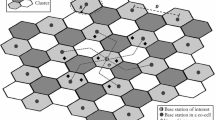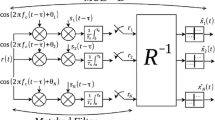Abstract
In this paper we study the effect of multipath propagation on the performance of the forward link of a CDMA cellular system. We assume that RAKE receivers are used by the mobile terminals to receive the multipath signals and derive signal-to-noise ratios (SNR) for the RAKE receiver output for both orthogonal and non-orthogonal spreading sequences. These SNR expressions are evaluated using real impulse response measurement data obtained in the city of Toronto and comparisons are made between urban and suburban environments. We have found that even though multipath propagation tends to destroy the orthogonality of signals in an orthogonal CDMA system, the system with orthogonal CDMA codes still performs significantly better than a system utilizing random spreading codes in realistic multipath propagation environments.
Similar content being viewed by others
References
R. Price, P. E. Green, Jr., “A communication technique for multipath channels”, Proc. IRE, vol. 46, pp. 555–570, 1958.
G. L. Turin, “Introduction to spread-spectrum antimultipath techniques and their application to urban digital radio”, Proc. IEEE, vol. 68, pp. 328–353, 1980.
U. Charash, “Reception through Nakagami fading multipath channels with random delays”, IEEE Trans, on Communications, vol. COM-27, pp. 657–670, 1979.
H. Xiang, “Binary code-division multiple-access systems operating in multipath fading, noisy channels”, IEEE Trans. on Communications, vol. COM-33, pp. 775–784, 1985.
D. E. Borth, M. B. Pursley, “Analysis of direct-sequence spread-spectrum multiple-access communication over Rician fading channels”, IEEE Trans. on Communications, vol. COM-27, pp. 1566–1577, 1979.
A. Jalali and P. Mermelstein, “Power control and diversity for the downlink of CDMA systems”, Proc. Second International Conference on Universal Personal Communications, pp. 980–984, Ottawa, Canada, 1993.
E. S. Sousa, V. M. Jovanovic, and C. Daigneault, “Delay spread measurements for the digital cellular channel in Toronto”, to appear in IEEE Trans, on Veh. Tech.
J. G. Proakis,Digital Communications, McGraw-Hill Book Company, New York, 1989, p. 731.
A. Papoulis,Probability, Random Variables, and Stochastic Processes, McGraw-Hill, Inc., New York, 1991, p. 111.
V. M. DaSilva, E. S. Sousa, “Multicarrier orthogonal CDMA signals for quasi-synchronous communication systems,” IEEE Journal on Selected Areas in Communications, Vol. 12, pp. 842–852, 1994.
Author information
Authors and Affiliations
Additional information
This work was supported in part by Bell Mobility Cellular and in part by the Information Technology Research Center of Ontario (ITRC).
Rights and permissions
About this article
Cite this article
DaSilva, V.M., Sousa, E.S. & Jovanović, V. Effect of multipath propagation on the forward link of a CDMA cellular system. Wireless Pers Commun 1, 33–41 (1994). https://doi.org/10.1007/BF01098503
Issue Date:
DOI: https://doi.org/10.1007/BF01098503




